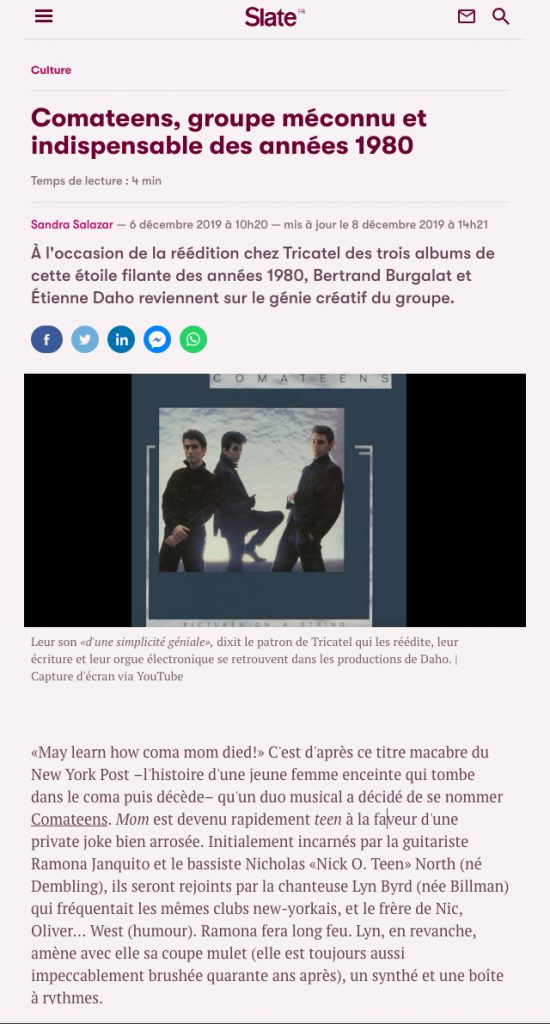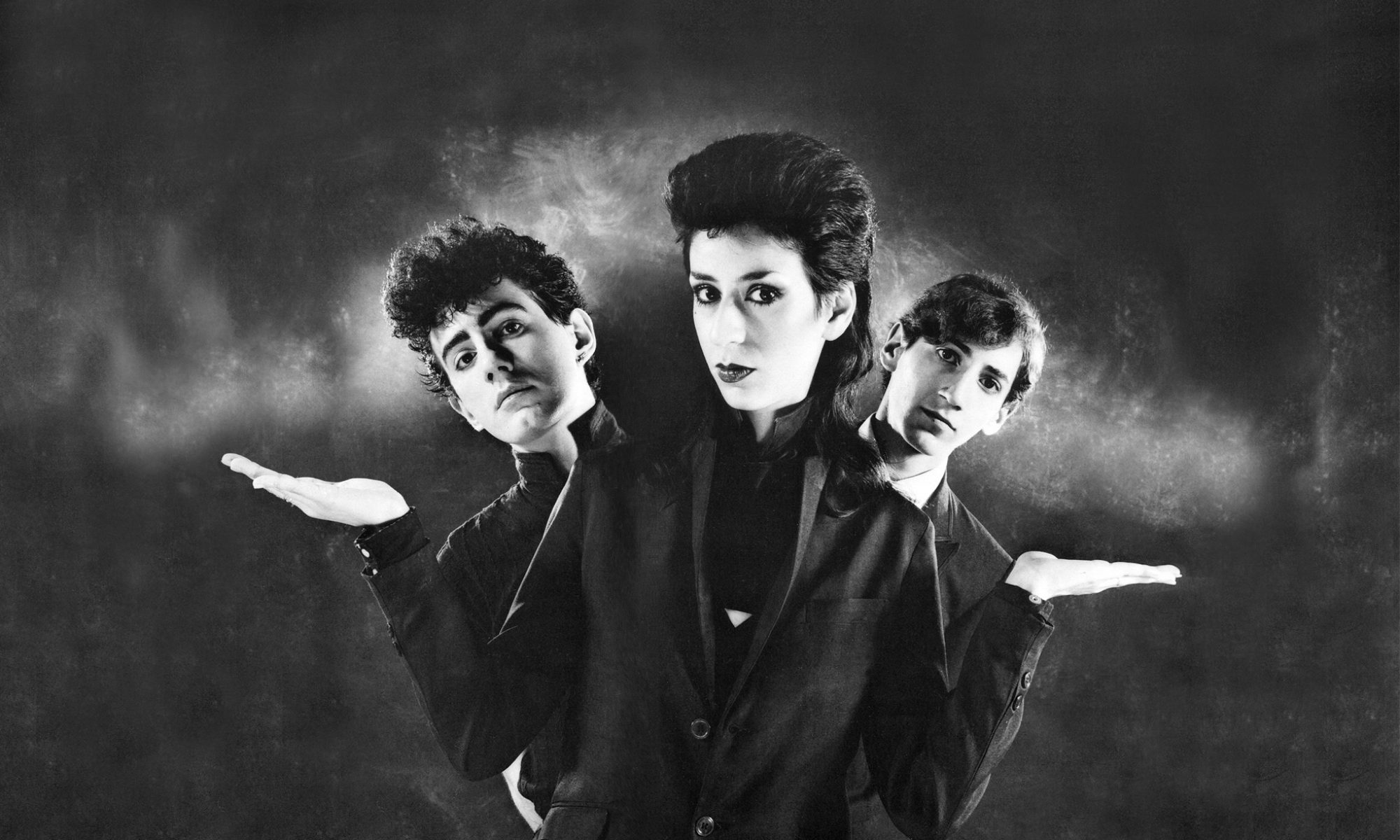
 12/08/2019
12/08/2019
“Less radical than Suicide, more fun and second degree than the new romantics…”
Comateens, a little-known and indispensable group from the 1980s
Sandra Salazar
On the occasion of the reissue at Tricatel of three albums from this shooting star of the 1980s, Bertrand Burgalat and Étienne Daho look back at the creative genius of the group.
Their sound “of a brilliant simplicity,” says Tricatel’s boss, who reissues them, their writing and electronic organ are reflected in Daho’s productions.
“May Learn How Coma-mom Died!” It is according to this macabre headline of the New York Post – the story of a young pregnant woman who falls into a coma and then dies – that a musical duo decided to call themselves Comateens. Mom quickly became a teen thanks to a well-watered private joke. Initially played by guitarist Ramona Janquito and bassist Nicholas “Nick O. Teen” North (née Dembling), they will be joined by singer Lyn Byrd (née Billman) who attended the same New York clubs, and Nic’s brother, Oliver… West (humor). Ramona will fizzle away. Lyn, on the other hand, brings her rooster cut (she is still as impeccably brushed forty years later), a synth and operate a drum machine.
These last elements become crucial in what will be the sound of Comateens, namely a mixture of graceful melodies supported by a (quasi) Bontempi organ , a minimal beatbox and funky guitar riffs, dry and effective. Less radical than Suicide, more fun and second degree than the new romantics that will soon emerge, Comateens create unidentified lo-fi musical objects, at the crossroads of low-budget horror film music, from cartoon credits and pop hits to classical writing and electronic dressing.
Big in France
Their freshness and originality soon became popular in Europe and especially in France, where they influenced a wide spectrum of pop artists, from Indochine (who opened for Comateens at Rose Bonbon) to Étienne Daho, who met them thanks to their common manager, Fabrice Nataf, and stayed at their home in the early 80s. “I loved their first album. My album, “Le Grand Sommeil” was released on a compilation in the US and I had to do a showcase at Danceteria in New York. We became friends very quickly. It’s a no-brainer. I lived with them in Washington Heights. I had caught a virus in Turkey where I was doing TV and I was at the end of my life. I don’t remember making songs with them, but setting fire to their kitchen trying to prepare a French meal for them that ended up in the trash. When they came to France in 1984, they asked me to be a guest on their tour. I was speaking on two tracks, Get Off My Case and Cold Eyes.”
“All three have invented a rather unique style.”
—Étienne Daho, singer-songwriter
The relationship between Daho and the duo (Oliver died of an overdose in 1987) never faded. “Nick and I wrote songs that I love like Retour à Toi, Les Jalousies on the album Réévolution, Miss You and especially the beautiful Soudain on Eden. What a gift! We had also recorded an EP that was unreleased for a long time, Comateens vs. Daho, but which finally came out on the Eden Deluxe box set. Nick has written Christmas songs that I will be recording soon. Lyn guest stars on a bunch of titles: Miss You, Un Serpent Sans Importance, Toi+Moi… Nick is an outstanding composer, a genius and his great songs are timeless. Oliver was an incredible rhythm guitarist. And Lyn is an eccentric and awesome character. A star. I’m the president of Lyn’s fan club. Our relationships are a little hysterical, I communicate with her by shouting or onomatopoeia. It’s been like this for thirty-five years. All three have invented a rather unique style. Burgalat had a great idea to finally release their albums.”
At the Heart of Tricatel
Like Daho, Bertrand Burgalat is a fan of the first hour: “I knew them through Best and Rock and Folk, and friends of the music scene of the time. The credits of a show of a brilliant free radio, Radio Cité Future, took up The Munsters Theme (on the first album). I saw them at The Rose Bonbon and every time I heard their music, I was always struck by their freshness, their simplicity, the purity of their vocal harmonies and their writing. For me, they’re the Simon and Garfunkel of electronics.
“For example, the bridge of Late Night City is of great refinement. They have a very classic writing style, and that’s what makes it age well. They have been copied a lot, in a cartoonish, simplistic way, but they are of a brilliant simplicity, and nothing is left to chance. And then you can play Don’t Come Back at any party, everyone dances!”
It was therefore with the idea of doing justice to an essential and too little-known group of the 80s that this reissue was conceived, from the original masters, that Comateens had retained. The object is embellished with documents and period articles.
Comateens Discography
After their first vinyl in 1981, composed of a few original tracks and a lot of even more original covers, such as Bowie’s TVC15—you can’t jump more than that—and Lovin’ Spoonful’s Summer in the City, which is furiously reminiscent of video game music, Comateens trio released a second album entitled Pictures on a String in 1983. It contains the dance hit Get Off My Case, which Etienne Daho sometimes performs with them on stage, as was the case on November 11 in Paris (“It was crazy to be on stage at the Philharmonie after so many years, both unreal and so obvious. The audience gave them a triumph,” says Daho himself).
The style of the twelve tracks remains very eclectic, with Latin nods to the Kid Creole, Blondie pop or orientalizing experiments. The third album, Deal With it, was released in 1984 and promised to be much less lo-fi, much more produced and more successful songwriting. Undeniably, the material has gone upmarket, but the freshness of the beginnings is still there, with an irresistible hit: Don’t Come Back. Some will remember their TV stint at Les Nuls, as they tried to do a French-style “Saturday Night Live”. That live performance gives us as a bonus one of those indispensable saxophone solos of the 80s.
This article was translated from the original French.
Comateens, groupe méconnu et indispensable des années 1980
Sandra Salazar — 6 décembre 2019 à 10h20 — mis à jour le 8 décembre 2019 à 14h21
À l’occasion de la réédition chez Tricatel des trois albums de cette étoile filante des années 1980, Bertrand Burgalat et Étienne Daho reviennent sur le génie créatif du groupe.
«May learn how coma mom died!» C’est d’après ce titre macabre du New York Post –l’histoire d’une jeune femme enceinte qui tombe dans le coma puis décède– qu’un duo musical a décidé de se nommer Comateens. Mom est devenu rapidement teen à la faveur d’une private joke bien arrosée. Initialement incarnés par la guitariste Ramona Janquito et le bassiste Nicholas «Nick O. Teen» North (né Dembling), ils seront rejoints par la chanteuse Lyn Byrd (née Billman) qui fréquentait les mêmes clubs new-yorkais, et le frère de Nic, Oliver… West (humour). Ramona fera long feu. Lyn, en revanche, amène avec elle sa coupe mulet (elle est toujours aussi impeccablement brushée quarante ans après), un synthé et une boîte à rythmes.
Ces derniers éléments deviennent cruciaux dans ce que sera le son des Comateens, à savoir un mélange de mélodies gracieuses soutenues par un (quasi) orgue Bontempi, une beatbox minimale et des riffs de guitare funky, secs et efficaces. Moins radicaux que Suicide, plus fun et second degré que les nouveaux romantiques qui vont bientôt émerger, les Comateens créent des objets musicaux lo-fi non identifiés, à la croisée de la musique de film d’horreur à petit budget, du générique de dessin animé et de tubes pop à l’écriture classique et à l’habillage électronique.
Big in France
Leur fraîcheur et leur originalité ne tardent pas à faire des adeptes en Europe et plus particulièrement en France, où ils vont influencer un large spectre d’artistes pop, d’Indochine (qui joue en première partie des Comateens au Rose Bonbon) à Étienne Daho, qui les rencontre grâce à leur manager commun, Fabrice Nataf, et séjourne chez eux au début des années 1980. «J’avais adoré leur premier album. “Le Grand Sommeil” était sorti sur une compile aux États-Unis et je devais faire un showcase à la Danceteria à New York. Nous sommes devenus amis très vite. Une évidence. J’ai habité chez eux à Washington Heights. J’avais chopé un virus en Turquie où je faisais une télé et j’étais au bout de ma vie. Je ne me souviens pas d’avoir fait des chansons avec eux, mais d’avoir mis le feu à leur cuisine en tentant de leur préparer un repas français qui a fini à la poubelle. Lorsqu’ils sont venus en France en 1984, ils m’ont demandé d’être guest sur leur tournée. J’intervenais sur deux titres, “Get Off My Case” et “Cold Eyes”.»
«Tous les trois ont inventé un style assez unique.»
— Étienne Daho, auteur-compositeur-interprète
La relation entre Daho et le duo (Oliver est décédé d’une overdose en 1987) ne s’est jamais étiolée. «Nick et moi avons écrit des chansons que j’adore comme “Retour à Toi”, “Les Jalousies” sur l’album Réévolution, “Me Manquer” et surtout le magnifique “Soudain” sur Éden. Quel cadeau! Nous avions aussi enregistré un EP resté longtemps inédit, Comateens vs Daho, mais qui est enfin ressorti sur le coffret Éden Deluxe. Nick a écrit des chansons de Noël que j’enregistrerai bientôt. Lyn intervient sur plein de titres en guest star: “Me Manquer”, “Un serpent sans importance”, “Toi+moi”… Nick est un compositeur hors pair, un génie et les grandes chansons traversent le temps. Oliver était un incroyable guitariste rythmique. Et Lyn est un personnage excentrique et génial. Une star. Je suis le président du fan club de Lyn. Nos relations sont un peu hystériques, je communique avec elle par cris ou onomatopées. C’est comme ça depuis trente-cinq ans. Tous les trois ont inventé un style assez unique. Burgalat a eu une grande idée de ressortir enfin leurs albums.»
Au cœur de Tricatel
Tout comme Daho, Bertrand Burgalat est un fan de la première heure: «Je les connaissais via Best et Rock & Folk, et des copains de la scène musicale de l’époque. Le générique d’une émission d’une radio libre géniale, Radio Cité Future, reprenait le thème des “Monstres” (sur le premier album). Je les ai vus au Rose Bonbon et chaque fois que j’ai entendu leur musique, j’ai toujours été frappé par leur fraicheur, leur simplicité, la pureté de leurs harmonies vocales et de leur écriture. Pour moi, ce sont des Simon et Garfunkel de l’électronique.
«Par exemple, le pont de “Late Night City” est d’un grand raffinement. Ils ont un style d’écriture très classique, et c’est ce qui fait que ça vieillit bien. Ils ont été beaucoup copiés, de manière caricaturale, en faisant du simplisme alors qu’eux sont d’une simplicité géniale, mais rien n’est laissé au hasard. Et puis, tu peux passer “Don’t Come Back” dans n’importe quelle soirée, tout le monde danse!»
C’est donc dans l’idée de rendre justice à un groupe essentiel et trop méconnu des années 1980 que cette réédition a été conçue, à partir des masters d’origine, que les Comateens avaient conservé. L’objet est agrémenté de documents et d’articles d’époque.
La discographie des Comateens
Après un premier vinyle en 1981, composé de quelques titres originaux et de pas mal de reprises encore plus originales, telles que le «TVC15» de Bowie –on ne peut plus sautillant– et le «Summer in the City» de Lovin’ Spoonful, qui fait furieusement penser à une musique de jeu vidéo, le trio Comateens sort en 1983 un second album intitulé Pictures on a String. Il contient le tube dance «Get Off My Case», qu’Etienne Daho reprend parfois en leur compagnie sur scène, comme ce fut le cas le 11 novembre dernier à Paris («C’était dément de se retrouver sur scène à la Philharmonie au bout de tant d’années, à la fois irréel et si évident. Le public leur a fait un triomphe», dixit Daho himself).
Le style des douze titres reste très éclectique, avec des clins d’œil latinos à la Kid Creole, à la pop de Blondie ou des expérimentations orientalisantes. Le troisième album, Deal With it sort en 1984 et s’annonce nettement moins lo-fi, beaucoup plus produit et au songwriting plus abouti. Indéniablement, le matériel a monté en gamme, mais la fraîcheur des débuts est toujours là, avec un tube irrésistible: «Don’t Come Back». Certains se souviendront de leur passage télé chez les Nuls, alors qu’ils tentaient de faire un «Saturday Night Live» à la française.
Le live nous gratifie en prime de l’indispensable solo de saxophone des années 1980.

